
17 minute read
Letters
from August 11, 2021
by Ithaca Times
Continued From Page 6
homes data, the use of state resources for a personal book deal, and withholding of information about the structural integrity and contracts with the Mario Cuomo bridge. I support and agree with the sentiment of my constituents that the impeachment proceedings should move
Advertisement
ALGAE BLOOMS
Continued From Page 3
mowing their lawn all the way down to the water and instead consider growing a buffer of flowers to prevent fertilizer from the lawn from running into the lake when it rains. She added that they’ve been working with farmers as well to make sure they aren’t letting things like animal waste or fertilizer from their farms get into the lake, but “when it rains two inches in two hours, farm fields get overwhelmed and soil sweeps into the lake.”
But some factors at play are a lot bigger than fertilizer and farming fields — climate change is also a cause of the increase in HABs, Launer said.
“These blooms like warmer water, so the faster it warms up and the later it stays warm, that really helps blooms do well,” he said. “And also the rain storms are a factor of climate change that we’re facing and will continue to face. They can cause erosion and run off and will force more nutrients into our streams and lakes.”
Lambert noted that the lake has risen a couple degrees in recent years, and at the shallow shelves on either end, volunteers were reporting temperatures of 70 degrees by June, which is “way above what you would expect.”
While preventing HABs is difficult, spotting them is pretty easy.
“These blooms have pretty striking appearances,” Launer said. “It can look like spilled green paint on the water, deep green pea soup, or sometimes it looks like green dots dispersed throughout the water column. They show a streakiness on the water, with parallel streaks almost like an oil appearance.”
He added that cyanobacteria are single-celled organisms, so they have no structure. If it’s something that looks like it could be scooped up, it’s not a bloom.
Unfortunately, once there’s a bloom, there’s no way to treat it.
“You just have to wait it out,” Launer said.
Lambert said a change in weather can often help, such as rain, wind or a drop in temperature, but admitted sometimes it takes a while for them to dissipate. Launer said a good rule of thumb is to wait until 24 hours after the bloom has disappeared before going in the water.
The blooms have been particularly intense this year, with Launer noting that around the third week of July the lake had widespread blooms on the southern end of the lake with more than 25 reports coming in over a few days. Lambert added that forward. We should be as expeditious and thorough as possible. It is the Assembly’s responsibility to present a strong and thorough case to the Senate where an impeachment trial will take place if they choose to pursue this course of action.”
the first widespread bloom of that type occurred in 2017, and that it’s been a problem around the world in recent decades.
“Globally this is a rising problem with warming trends, and we are unfortunate that it’s finally arrived on our beautiful lake,” she said.
If you are exposed to a bloom, Launer said you should immediately rinse off in clean water and then call the Health Department for next steps. He and Lambert noted that the HABs produce a lot of chemical compounds and not all of them are toxic to humans, but that it’s better to be safe than sorry. The Tompkins County Health Department lists some of the symptoms to be aware of as vomiting, nausea, diarrhea, skin, eye or throat irritation, allergic reactions or breathing difficulties.
It’s also important to note that HABs are also toxic, and often fatal, to dogs.
However, despite the seemingly sinister nature of the algal blooms, Lambert doesn’t want people to panic.
“People should not be frightened or decide they’re never going swimming again,” she said. “Don’t panic. It’s going to be around for a while but the lake is healthy.”
To track and monitor HABs in Cayuga Lake, the Community Science Institute has a team of volunteers called HABs Harriers. The volunteers cover about 60% of the shoreline and report once a week on their designated section. They monitor the water for blooms, and if they see one they report it to Launer, describe it and take a sample, and it gets recorded and analyzed in the lab.
Members of the public can also make a report if they suspect a bloom by taking a photo, noting the location and sending an email to habshotline@gmail.com or by filling out the form at http://www.communityscience.org/cayuga-lake-2018-harmfulalgal-blooms-results/report-a-hab/.
That page also has an interactive map with confirmed locations of HABs, so people can check online before heading to the water to swim. You can find it at http:// www.communityscience.org/volunteer/ harmful-algal-bloom-monitoring/cayugalake-habs-reporting-page/.
The New York State Department of Environmental Conservation also has a map to track reported blooms. That can be found at https://nysdec.maps.arcgis.com/ apps/webappviewer/index.html?id=ae9114 2c812a4ab997ba739ed9723e6e. -Tanner Harding
THE TALK AT
YOUR LETTERS
Stop dumping trash in Fall Creek
Ilive in the Fall Creek neighborhood and have been concerned by the amount of trash that has been dumped in the past couple weeks as people’s leases have ended. Although I enjoy the common custom for neighbors to leave out free items to score like books, tennis racquets and lamps, the trash in question is far beyond a few household items to be donated after a few days when they remain unwanted. In several locations there are currently massive amounts of refuse including furniture and other strewn household items left behind on the curb by the exiting July tenants. Now these items are rain damaged and dirty. As the trash has sat for two weeks in some places, I looked into complaining about the detritus. A nice worker at the Tompkins County Recycling and Solid Waste Center informed me that the former illegal dumping enforcer retired a year ago. The folks over there stated they don’t know who enforces dumping fines after he left, and they suggested I call the Ithaca police non-emergent phone line.
The person at the police department I spoke to also seemed unsure about who, if anyone is enforcing illegal dumping fines. He did, however, say he would look into this complaint. I passed along the info I heard about the dumping enforcer retiring one year ago.
This gap in enforcement explains the astounding breadth of dumping I’ve seen in the Fall Creek area in the last few weeks! A walk in the neighborhood around Farm/Tioga/Aurora streets might have some interesting pictures for an article.
-Emma D., Fall Creek Resident, Ithaca, NY
Re: Where are all the bikes?
Idon’t miss ‘em one bit. I am a strong advocate for bicycling and all human powered modes of transportation to help us enjoy the world around us as we move from point A to Point B... but, and this is an all caps BUT, I am not an advocate for dockless bikes. My primary issue is my concern for user and other traveler safety, and because I believe that this type of use-and-abandon transportation system encourages irresponsibility on the part of both the user and owner. In regard to safety, it has been my observation that dockless bikes are most frequently utilized by “casual” users, who do not wear helmets, and likely have limited “investment” in learning (and following) bicycle safety etiquette. As another reader pointed out, people who are ill prepared (dress, level of intoxication, or who lack bike handling skills) are the most likely users.
As to “responsibility”, I came of age in the ‘70’s and I worked all summer in order to buy my first ten speed. It was awesome! But I quickly learned that with my new found freedom, came responsibility... I learned to maintain my bicycle, and I learned and followed the rules of the road. These investments have paid off by providing me with a life-long and sustainable transportation option. My fear is that dockless biking systems encourage the “bad egg” irresponsible riders, who inadvertently stoke the critics of biking. And as to the owners of dockless bike programs, most of these owners are nonlocal, stock market investers with little regard for local concerns or for proper bicycle maintenance etiquette (it pains me to see their bikes left out in all weather, and be regarded as disposable) . I also would like to point out that these bikes are each rolling/stationary advertisements for a business, given their distinctive colors and signage. No other local business enjoys this level of free advertising, nor storage and display... and lastly, it is my belief that the dockless bikes are an insult to both aesthetics and function (one size does not fit all, and it pains the eye to see these neon, clunky beasts scattered about).
If our goals are health and safety and sustainability, then that is not what this industry is offering. There are better ways to achieve these goals for a much wider spectrum of our community and its guests, and at nominal cost to us. For example- Guest houses can maintain a small number of their own bikes to offer their customers, commuters can own and maintain their own bicycles, and casual users can instead simply walk the 1/2 mile (average distance traveled by LimeBike users) on our wonderful sidewalks. And with our encouragement and support, our own local bike shops could provide appropriate equipment and services to those residents and guests wishing to experience both traditional and specialized biking (Ebikes, trikes, and equipment suited for longer road distances, and off road bicycling). -John G. Wertis, via Ithaca.com
Write to us!
Say something or respond to an article by writing editor@ithacatimes.com. Letters must be signed and include an address and phone number. We do not publish unsigned letters. Letters may be edited for length and readability.
To the Editor, Ithaca Times, 109 N Cayuga St., Ithaca, NY 14850
PATCHWORK POLICIES
Business work individually to find the best way to keep people safe from COVID-19
By Faith Fisher
T
ake a stroll down the Ithaca Commons, and you will find freshly printed signs decorating the windows of many businesses. Following an uptick in COVID-19 cases in the county and new recommendations from the CDC, these colorful signs inform customers of updated in-store public health measures.
From mask requirements to vaccine requirements, businesses in the area have implemented a patchwork of different COVID-19 policies informed by county public health recommendations and tailored to the specific needs of the respective establishments.
On July 30, The Tompkins County Health Department issued a new health advisory encouraging local organizations and individuals to wear a mask while indoors regardless of vaccination status. The countywide health advisory conforms to updated federal guidance from the CDC following increased transmission of the more contagious delta variant. The federal guidance states that in communities with over 50 cases per 100,000 residents, fully vaccinated individuals should consider wearing a mask while indoors.
Tompkins County reached that threshold at the end of July, triggering the advisory. As anxieties and confusion mount, Tompkins County government officials hosted a virtual COVID-19 update on August 5th to discuss vaccinations, mask guidance, and community reopening. According to Tompkins County Medical Director Dr. Bill
Klepack, the delta variant accounts for over 80% of cases nationwide, and it spreads more easily between individuals. In addition to recommending wearing masks while indoors, the officials at the meeting pushed vaccinations as the most effective way to mitigate the spread of COVID-19 and prevent new variants.
“The numbers that you see in terms of preventing severe disease and hospitalization really, really show that you should get vaccinated,” Dr. Andreia de Lima of Cayuga Medical Center said. “And the mask wearing is not even just for you, it’s to protect other people so they don’t get infected...The safest thing to do is to wear masks again. We did it before, we can do it again.”
Despite the changed guidance, Cayuga Health System CEO Dr. Martin Stallone urged community members to stay calm, especially considering the high vaccination rate in the county— approximately 69% of individuals ages 18 and older have completed the vaccine series. Although cases have spiked with the prevalence of the delta variant, the number of COVID positive patients requiring hospitalization remains extremely low.
“Even with the variant, the immunization is very effective,” he said. “Whatever immunization, all of the platforms are very effective at avoiding the need for hospitalizations, ICU-level care, and death.”
The recommendations in the health advisory do not amount to a mask mandate, but it does ask individuals to practice caution for the benefit of the community. This includes wearing a face covering to lower the risk of transmitting the virus. In general, the community — on the individual and organizational level — has been receptive to the recommendations.
“I think people are tired of the whole masking thing, but they also are understanding that as a community, we’ve done a lot to get as far as we have,” Deputy County Administrator Amie Hendrix said. “Seeing the rise in cases here in Tompkins County I think they understand that the health department is really weighing the safety of the community when we put out any of these advisories.”
New York state has not implemented new statewide mask rules. Nevertheless, following the new federal guidance, many large national corporations with locations in the county have reinstated mask requirements for their workers in many stores, regardless of vaccination status. Store patrons are highly encouraged — though not required — to wear a face covering. Some of these retailers and restaurants include Wegmans, Target, McDonald’s, and Home Depot.
With more autonomy when it comes to formulating store-specific policies, private businesses in the Ithaca area can decide to
enforce their own mandates and recommendations. The health department has been in communication with these establishments in the area to help them navigate the evolving guidance.


Masks are back at Angry Mom Record and Odyssey Books (Photo: Casey Martin)
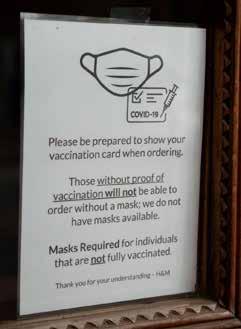
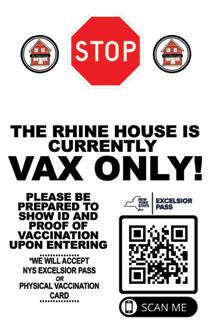
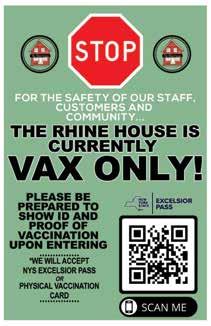
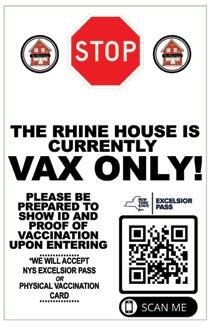



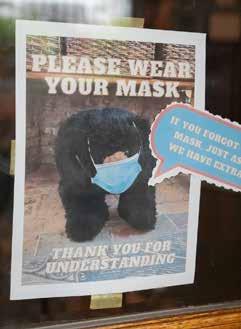
various signs on Ithaca Storfronts (Photo: Casey Martin)
“We did follow up directly with businesses and work with our various economic development partners to get out information about what a recommendation means and an advisory means versus a mandatory masking order like was done last year,” Hendrix said. “We have pretty consistent communication with the businesses as we start to make these decisions.”
When the health department put out new guidelines earlier this summer that relieved vaccinated individuals from the mask mandate, many businesses loosened their mask policies for employees and patrons. According to Kristina Thelen, business development director of the Downtown Ithaca Alliance, even though the most recent guidance falls short of a mask mandate, most businesses in the downtown area are once again requiring masks.
“The majority of businesses are taking the guidance very seriously and to heart,” she said. “Now the majority of businesses are very much prominently back on the train of just requiring masks.”
Angry Moms Records on the Commons is one of the establishments that has recently updated its masking policies on the heels of the new health advisory. Earlier this summer, the store exempted vaccinated individuals from wearing masks. However, citing fears of the delta variant, the store now requires that all employees and patrons wear a face covering while inside.
“We were kind of doing the honor system — if you’re vaccinated you don’t have to wear a mask — but now with the delta thing, we’re trying to get everyone to wear masks,” owner
George Johann said. “We had been going back and forth, and then once the health department made its announcement, we decided just to do it.”
For some businesses, the updated guidance has had little effect on in-store masking policies. Even when New York state lifted the mask mandate, many stores decided to keep their mask requirement intact. Thelen said that a major factor in this decision was the presence of children in the store.
“The majority of folks who do business downtown and have any interaction with children under the age of 12 have never dropped the mask policy, because children under 12 have not been eligible to be vaccinated as of yet,” she said. “So there’s a number of businesses who never stopped requiring masks.”
Odyssey Bookstore, situated on West Green Street, is one of these businesses. Owner Laura Larson said that she and the bookstore manager discussed the mask requirement almost every week, and decided to stay on “the more cautious side of best practices.” This summer the store considered relaxing the requirement, however, the store quickly dropped this possibility with growing prevalence of the delta variant and the health advisory.
“Earlier, cases were really low and we were actually pondering lifting the requirement,” Larson said. “And then the delta cases started going up so we decided not to. So we’ve kept the requirement the entire time.”
Hound and Mare, located within the N Aurora St. Streatery, has taken a slightly different approach to in-store masking policies. When the mask mandate was lifted, the cafe continued to require masks unless customers could show proof of vaccination. Owner Christine Lam felt that this was the safest option for her customers and staff.
“My whole thought behind it was really because I have friends that haven’t been vaccinated, and they were just taking advantage of the fact that everyone was going on the honor code essentially,” she said.
Amid the spike in cases and new recommendations, the store will continue this policy. Although most people have been gracious about it, employees have had to deal with some displeased customers.
“There’s a surprising amount of people who have been very rude,” Lam said. “We’re living in a different world right now, and I just don’t think it is un- reason- able to ask for a vaccination card — and if you don’t have one that’s totally fine and it’s up to you — but i f you also don’t have a mask on top of that, I just don’t think it is responsible for us to allow that.”
According to Thelen, these decisions are difficult for businesses to make. It not only requires the formulation of the in-store policy, but also decisions about how — and to what extent — to enforce it. Especially after struggling through the pandemic, many businesses fear alienating customers with unfavorable requirements.
“Policing it is also an important part of the whole equation — providing good customer service but also not being at odds constantly with the public,” she said. “There are several places who turn people away if they won’t commit to the policy, but there are some people who aren’t going to turn people away. It just comes down to the confrontation aspect of it and their personal philosophies of customer service and such.”
The Rhine House on W Seneca St. has espoused the policy of turning potential customers away, but not for masking purposes. In order to enter the establishment, individuals must show proof of vaccination via the Excelsior Pass, a physical vaccination card, or a photo of the vaccination card. On a national level, the restaurant industry has been comparatively quicker than other industries to embrace vaccine mandates due to the particular devastation the pandemic generated for the sector.
Many business owners see vaccine requirements as a way to avoid lockdowns and social distancing requirements, which ensure fewer customers and threaten to hamper the industry’s comeback from the worst of the pandemic. Although the vaccination requirement was a difficult decision to make, The Rhine House owner Kate Conroy doesn’t see any “other route towards normalcy.” “We just decid ed that enough i s









